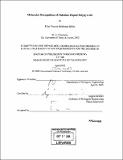| dc.contributor.advisor | Angela Belcher. | en_US |
| dc.contributor.author | Miller, Kiley Preston-Halfmann | en_US |
| dc.contributor.other | Massachusetts Institute of Technology. Biological Engineering Division. | en_US |
| dc.date.accessioned | 2006-08-25T18:52:11Z | |
| dc.date.available | 2006-08-25T18:52:11Z | |
| dc.date.copyright | 2005 | en_US |
| dc.date.issued | 2005 | en_US |
| dc.identifier.uri | http://hdl.handle.net/1721.1/33864 | |
| dc.description | Thesis (Ph. D.)--Massachusetts Institute of Technology, Biological Engineering Division, 2005. | en_US |
| dc.description | Vita. | en_US |
| dc.description | Includes bibliographical references (p. 108-111). | en_US |
| dc.description.abstract | The objective of this work is to functionalize an existing polymer such that it better mimics natural tissue for tissue growth and regeneration. Numerous other processes have tried and accomplished this by non-specific protein adsorption, covalent attachment, biomolecule entanglement, and synthesis of new polymers with the desired functionality. The focus of this work is to modify the polymer's binding capability to cells while not altering the bulk properties. Through the use of both phage display of peptide libraries and yeast surface display of scFv libraries the surface of chlorine-doped polypyrrole (PPyCl) has been modified to facilitate binding of neuronal phenotype cells. The selection of peptides using phage display found a surface specific recognition peptide (T59) that was made bivalent by altering the C-terminus with an integrin binding epitope. The bivalency of the modified T59 peptide was exploited to tether phenochromocytoma (PC12) cells to the surface of PPyCl. Furthermore the tethering of the cells to PPyCl through the peptide does not decrease the cells neuronal function and maintains the bulk conductive polymers characteristics. Using the peptide as a bivalent linker, the addition of other types of cells, drugs, growth factors, and enzymes could be incorporated for various biomedical applications. | en_US |
| dc.description.abstract | (cont.) An antibody (Y2) specific to PPyC1 was found using yeast surface display. This antibody was utilized to mediate cellular binding to PPyCl by expression of the antibody on the surface of PC12 cells. Complimenting the peptide studies of having an exterior bivalent linker the antibody recognition provides the means for any cell type to adhere to PPyCl, through expression of the antibody on the surface of the cell. This type of system could be used for various types of tissue growth supports. | en_US |
| dc.description.statementofresponsibility | by Kiley Preston-Halfmann Miller. | en_US |
| dc.format.extent | 112 p. | en_US |
| dc.format.extent | 7049171 bytes | |
| dc.format.extent | 7053881 bytes | |
| dc.format.mimetype | application/pdf | |
| dc.format.mimetype | application/pdf | |
| dc.language.iso | eng | en_US |
| dc.publisher | Massachusetts Institute of Technology | en_US |
| dc.rights | MIT theses are protected by copyright. They may be viewed, downloaded, or printed from this source but further reproduction or distribution in any format is prohibited without written permission. | en_US |
| dc.rights.uri | http://dspace.mit.edu/handle/1721.1/7582 | |
| dc.subject | Biological Engineering Division. | en_US |
| dc.title | Molecular recognition of chlorine-doped polypyrrole | en_US |
| dc.type | Thesis | en_US |
| dc.description.degree | Ph.D. | en_US |
| dc.contributor.department | Massachusetts Institute of Technology. Department of Biological Engineering | |
| dc.identifier.oclc | 66292312 | en_US |
